Fashion Studies at Montclair State – “Dazzling” Historic Costume Exhibition – by Alexandra Thelin
Posted in: Guest Essay
A great museum exhibition is a thrill to behold.
A variety of historic artifacts on display in cases with a blurb describing each item, whether it be a collection of paintings from the Abstract Expressionist period; a room of Medieval wall tapestries; or mannequins wearing American women’s fashion from 1880-1940 — there is something about seeing a piece of history.
As a young girl, I remember many trips to The Metropolitan Museum of Art with my great aunt, where we wandered and took in all the sights of the museum’s prolific galleries. Around this time I understood that I wanted to be an “artist” – or someone who worked in the art field.
I chose Art History as my major as an incoming freshman to Montclair State University in September, 2001. Experiencing my first Art History class lectures solidified my beliefs that this was indeed the field for me. Upon graduation, I attended Montclair State University for a Master’s Degree in Theatre with a concentration in Arts Management as well as the Fashion Institute of Technology for a second Master’s Degree in Fashion and Textile Studies: History, Theory and Museum Practice.
Projects for all three degrees included creating multiple small-scale exhibitions with artwork placement and writing succinct and informative label text. My multiple internships involved exhibition set up and visual merchandising. At FIT, the students in my graduating class were in charge of curating, designing, and creating an exhibition on the iconic shoe designer, Christian Louboutin.
And so, you can imagine my excitement when I became an adjunct here at MSU in Fashion Studies, where now I teach Historical Analysis of Costume. At the start of my second semester, we moved to the renovated basement of the Fox Theatre Building, with dedicated climate-controlled storage for the Department’s Historic Costume Collection, new classrooms, and a dedicated exhibition space where I was asked to have my class design the very first exhibition installation.
With expert and dedicated help from Dr. Linda Reilly, Dr. Abby Lillethun, and the Historic Costume Collection student assistant, Samantha Stutler, we picked garments and accessories from the Collection that had some element of sequins or beadings.
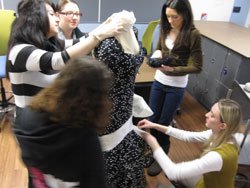
Why sequins or beads? Well, one afternoon, Dr. Lillethun and I were rummaging through the boxes in the collection and we found several garments with beading. It was the ideal theme for categorizing more garments, through which we figured that students would become even more receptive to the upcoming project. It was then that the title of the exhibition — “Dazzling” — emerged. Samantha pulled many garments and accessories that fit under that special qualifier.
A snow day…and a delayed exam later…we finally arrived on campus one morning to install. Unlike exhibitions where there are many months of planning, the students were the ones making the executive decisions about item choices, placement, and design. We had a few pieces of washed and un-ironed muslin to provide the backdrop and floor covering for the exhibition space. The sequins and beading gave the glitz; the muslin and industrial metal of the mannequin stands were a juxtaposition to the splendor.
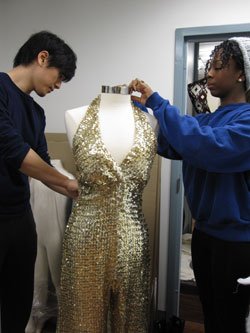
The students worked together — dressing mannequins, displaying the elements, and designing the space. For some, it was their first hands-on experience with historic garments and exhibition display. Others had worked in retail or on fashion internships and were familiar with mannequins and visual marketing.
We hope this experience has solidified the love of the arts and fashion field for the students involved, and I am looking forward to having future students feel the same way.
Virtual Exhibition Checklist
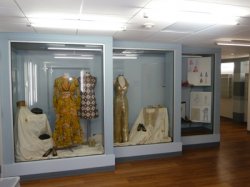
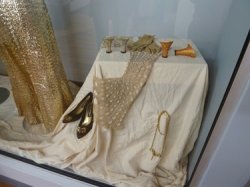
The following items were chosen for “Dazzling” by the Fashion Studies students at Montclair State University. In addition to the pieces from the Historic Costume Collection, student fashion illustration artwork is also displayed with coordinating historic accessories:
- Gold pillbox hat with net, mid 20th century
- Black lamé hat with velvet bow, mid 20th century
- Black net hat with sequins and bow, mid 20th century
- Black velvet pumps by The American Girl Shoe company, mid 20th century
- Gold tone costume jewelry, late 20th century
- Gold, orange, black and white paisley print dress with sequined belt, 1960-70
- Maroon and ivory shift mini-dress with silver metallic thread, 1960s
- Ivory satin pumps, 20th century
- Gold sequin halter jump suit, 1970s
- Black satin pumps by Fayva with gold sequin embellishments, mid-late 20th century
- Detachable decorative heels with crystals. (One gold pair, one silver pair), 1920s
- Gold gloves, mid-late 20th century
- Neck covering with seed beads on silk ground, 20th century
- Gold tone costume jewelry with ram decoration, late 20th century
- Gold woven t-strap heels, 20th century
- Pink velvet headpiece, 1940s
- Black patent leather pumps by Fayva, mid-late 20th century
- Gold tone costume jewelry with black beads, late 20th century
- Neiman Marcus sequined dress with white bow below waist, 1980s
You will note that the majority of items in the exhibition are from the mid-to-late-twentieth century. This is partly due to the fact that items from this time period are generally in good condition and can be handled and dressed on mannequins for proper exhibition. Although the Historic Costume Collection at Montclair State does contain pieces from earlier time periods, it is generally easier to find garments from a time period that is closer to that in which we live.
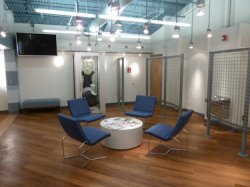
Many mid-twentieth century sequins are made out of cellulose acetate[1] and have endured well over time. One of the main concerns associated with sequins in a historic costume collection is loss or transfer of color. Another decorative element found in the garments on display is glass beading: the small, perforated bodies of beads are sewn onto fabric to make decorations and designs. Beads can be made to emulate gold and silver, and this is achieved by blowing gold or silver dust into hollow glass beads.[2] Sometimes beads are sewn onto a ground fabric that is not very sturdy, such as silk. The heavy beads can tear the delicate fabric over time, making display of the historic artifact both difficult and dangerous to the object. Fortunately, none of the garments on display had these concerns.
Perhaps the most intriguing items on display are the two pairs of detachable heels from the 1920s [items 11]. Shoes for a woman at this time were designed to have interchangeable heels to coordinate with various outfits. The base of the shoe stayed the same, but the heel could be removed and switched with another set. The Historic Costume Collection owns two pairs of these interchangeable heels, but not the corresponding pair of shoes. Both pairs are encrusted with jewels to draw the eye to the wearer’s feet. Dresses of the 1920s were also heavily beaded and decorated, so a jeweled heel was another touch of sparkle that helped complete an ensemble.
One of the ‘crowd favorite’ items in the exhibition is the 1970s sequin halter jumpsuit. This type of garment would have been perfect for a night of disco dancing. The halter top wraps around the neck and has a cinched-in waist with long, wide pants.
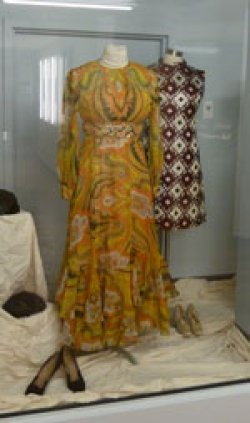
The 1960s shift dress is a good example of the mini skirt length that was the epitome of the era. Instead of utilizing beads or sequins in its design, there are metallic threads woven into the fabric of the dress. The silver metallic thread catches light and shines.
All the garments and accessories on display have a touch of “sparkle” and are only a small representation of the Historic Costume Collection. This first installation taught us all a lot about time management, budget limitations, and what we could have done to make the space even better.
The new space is a blank canvas — and I can only imagine what the future holds.
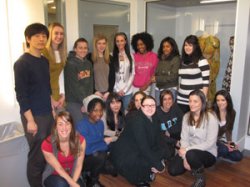
[1] George P. Fulton, “Sequins,” National Institute of Cleaning and Dyeing Bulletin Service 30 October 1948: T-205.
[2] K.S. Finch, “Beadwork,” Textile Conservation, ed. Jentina E. Leene (Washington, D.C., 1972) 210.
—Alexandra Thelin, MA, works in University Communications at Montclair State University, where she also serves as an adjunct professor in the Fashion Studies Department. Her graduate thesis at the Fashion Institute of Technology in New York City was on the conservation treatment and analysis of an eighteenth century woman’s calash bonnet. Alexandra also enjoys knitting, embroidery, sewing, and essentially anything associated with fashion and textiles.
